
|
|

January 11, 2008
WSCR (WMAQ) 670, Chicago
It's a new year here at Tower Site of the Week, and a new set of travel pictures to start us off. In August 2007, your editor and Mrs. Editor spent a few days traveling from her native Fort Wayne to Chicago, Milwaukee, Madison and then back to Fort Wayne via Rockford, Illinois, and along the way we had a chance to see some very significant broadcast sites.
In particular, we had a very productive afternoon on the west side of Chicago, visiting three historic and important 50 kW AM sites that we're honored to be able to share with you over the next few weeks.
In our last installment, we visited the Itasca transmitter site of CBS Radio's WBBM (780). This week's installment finds us about three miles away and 110 kHz down the dial at a station that was once a fierce rival of WBBM - and is now a sister station.
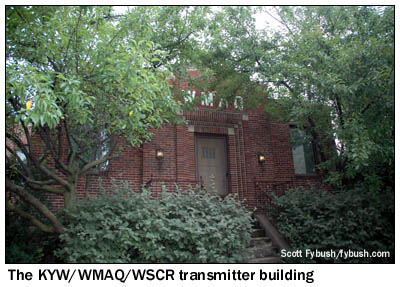
|
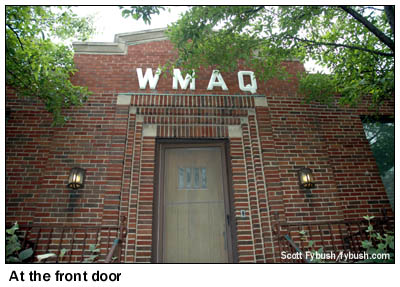 |
We knew the basic history of this site on Army Trail Road in Bloomingdale, just west of the I-355 tollway - that it was the longtime home of WMAQ (670), NBC's Chicago outlet, transferring to Westinghouse hands with the 1988 sale of NBC Radio and then to CBS almost a decade later, as Westinghouse absorbed CBS and longtime rivalries like that of WMAQ and WBBM (or WCBS/WINS, or KNX/KFWB) turned into partnerships. And of course we remembered that night in 2000 when the WMAQ calls left the Chicago radio dial for good, as CBS moved its all-sports WSCR down the dial from 1160 to this big 50 kilowatt nondirectional class I-A clear channel signal.
But here's what we didn't know: this wasn't WMAQ's original site - and when WMAQ moved here in 1935, the site already had a broadcast pedigree. It turns out that 63 years before Westinghouse bought this site from NBC, NBC had purchased it - for just a dollar - from...Westinghouse! For this very building was the transmitter site of Westinghouse's KYW, Chicago's pioneering radio station, which had been operating from transmitter sites within the city from its 1921 sign-on until its 1929 move to this site way out in the country. For all its pioneer status, though, KYW had to fight to retain its spot at 1020 on the dial after the "Davis amendment," which divided the country into five broadcast zones, allocated that spot to a different part of the country. Several other stations that were already operating in the designated region, including WWJ in Detroit, WCAU, WIP and WFAN in Philadelphia and WJAS in Pittsburgh all applied for 1020, and to defend its frequency, Westinghouse eventually had to move KYW out of Chicago.
So on December 3, 1934, Westinghouse pulled up stakes and moved KYW to Philadelphia, building the transmitter site in Whitemarsh Township, PA that the station calls home to this day. WMAQ, which had been operating from a transmitter site a few miles to the east in Elmhurst, IL, abandoned that location and took over this site. For the privilege, NBC paid Westinghouse all of one dollar!
(No, I don't know why the price was so low, though one could suspect it was tied into an agreement to make the new Philadelphia KYW an NBC affiliate. Any gratitude NBC might have had for the bargain price must have faded two decades later, when NBC strongarmed Westinghouse into trading its Philadelphia facilities for NBC's less-desirable Cleveland stations. The KYW calls thus moved again in 1956, to what had been WTAM in Cleveland, only to return to Philadelphia for good when a court ruling undid the Cleveland/Philadelphia swap in 1965. And before we move on to NBC's history in Addison, I should note that there's an excellent summary of WMAQ's pre-1935 history over at Rich Samuels' excellent Chicago broadcast history site.)
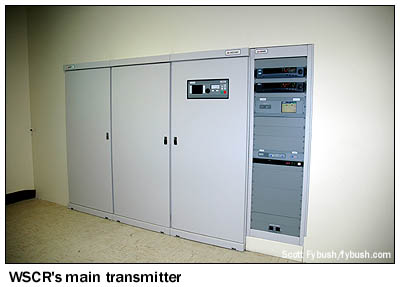
|
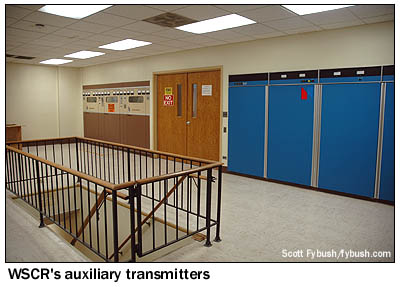
|
In any event, WMAQ signed on from the Bloomingdale building on Sept. 15, 1935, running 50,000 watts from a Westinghouse 50B water-cooled transmitter. (I'm indebted to Jeff Glass' WMAQ 670 Transmitter Site page for the transmitter history of the NBC years here; I wonder, too, if the deal to purchase the new transmitter from Westinghouse might have figured into the low price of the real estate.)
Anyone entering the brick transmitter building back then would have been greeted by pretty much the same thing that greets visitors, few as they may be, today: a heavy wooden front door that leads into a hallway with offices on both sides.
|
|
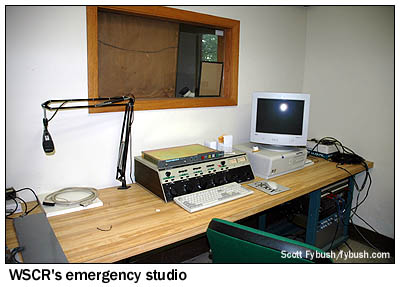
|
That hallway, in turn, leads to the big main transmitter room, which would once have been filled by the big Westinghouse transmitter. In 1960, the Westinghouse gave way to a RCA BTA-50H Ampliphase transmitter, and in 2006 the space once filled by the Ampliphase, off to the side of the main transmitter room, was in turn filled (well, partially occupied, anyway) by the station's current main transmitter, a Harris 3DX50 Destiny.
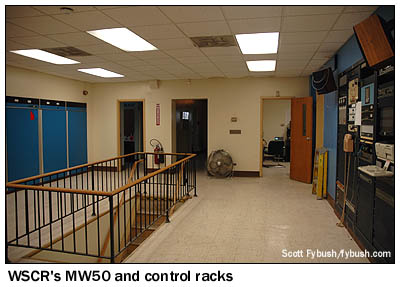 In the
meantime, the three other transmitters that are still in the
building had taken up residence around the room: a 5 kW RCA BTA-5R1
that came in with the Ampliphase in 1960 still sits across from
the 3DX50, used only rarely as a last-resort auxiliary tramsmitter.
In the
meantime, the three other transmitters that are still in the
building had taken up residence around the room: a 5 kW RCA BTA-5R1
that came in with the Ampliphase in 1960 still sits across from
the 3DX50, used only rarely as a last-resort auxiliary tramsmitter.
Over in the main room, across that stairwell that splits the room in half, there's a Harris MW-50B that came here in 1978 (it still sports the period-correct NBC "N" on one of its cabinet doors!) and the Continental 317C3 that came here in 1984, near the end of NBC's ownership.
(It was at that point that the building was extensively remodeled, creating the site we see today, give or take an Ampliphase and a 3DX50, of course.)
One corner of the main transmitter room is filled with STL and transmitter-control racks, and adjoining it is a last-resort emergency studio that looks out to the front hallway. (That's the door on the right in the photo above; that room also houses racks for WSCR's audio processing and switching gear.)
While there were never engineers living full-time at this site, there are kitchen and shower facilities on the main floor here as well.
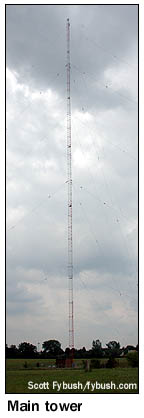 |
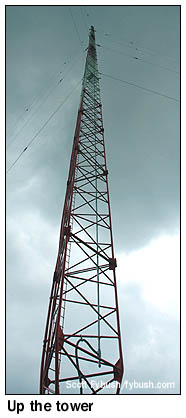 |
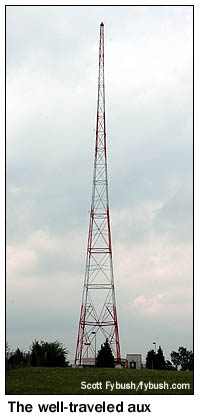 |
Down the stairs are electrical rooms, storage areas, a spacious garage, a bomb shelter - and a room that once housed the water still for the Ampliphase that's now home to the FM station that shares this site with WSCR. (And yes, I do still want to keep typing "WMAQ.") In 1992, WYSY (107.9 Aurora) moved closer in to Chicago, installing a two-bay FM antenna atop the 748-foot main AM tower here; today, the station is SBS' WLEY, "La Ley." (The engineer overseeing the move for then-owner Beasley? None other than Jeff Littlejohn, who'd later go on to much bigger responsibilities for Jacor and Clear Channel.)
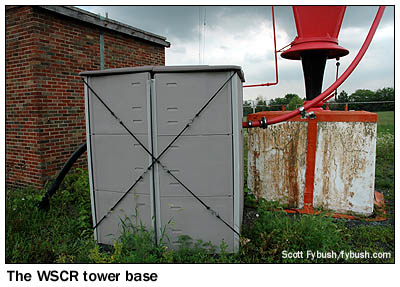 Getting
the FM signal across the insulated base of the tower requires
an isocoupler, and the WLEY isocoupler resides in an interesting
housing: a rubber storage shed that sits at the base of the tower!
Getting
the FM signal across the insulated base of the tower requires
an isocoupler, and the WLEY isocoupler resides in an interesting
housing: a rubber storage shed that sits at the base of the tower!
If the current 670 tower seems a little less massive than one might expect to see at such a venerable site, there's a reason for that: it's not quite as old as the rest of this site. WMAQ's original vertical tower collapsed in 1949, and while it was removed and rebuilt, NBC found an unusual way to get the station back on the air at high power.
The answer turned out to be a tower that RCA had in storage at its shortwave transmitter site near Bound Brook, New Jersey. This 250-foot self-supporting tower had been one of the support structures for the horizontal wire antenna at WTAM in Cleveland. And when that antenna was replaced by a vertical tower - the same one, if I'm not mistaken, that WTAM still uses at its site in Brecksville, Ohio - RCA then reused the tower as part of its display at the 1939 New York World's Fair, where it rose impressively, if only for show, above the RCA Exhibition Building to proclaim the impending wonders of television.
When the fair ended, the tower was dismantled and shipped to New Jersey, where it was ready for a quick train ride to Chicago to be pressed into service as an emergency antenna for WMAQ. When the emergency had passed and the new tower was standing tall, the shorter tower remained in place, and there it stands to this day, full of history that almost nobody knows.
But now you know (as a veteran Chicago broadcaster from another station might say) the rest of the story. In our next installment, we'll tackle even more Windy City radio history, moving south on I-355 and up the dial to that famous spot at 1000. "CFL" you next week...
Tower Site Calendar 2008 is here! Visit the Fybush.com Store now and get your calendar now!
- Previous Site of the Week: WBBM, Chicago
- Next Week: WMVP (WCFL), Chicago
- Site of the Week INDEX!
- How can you help support Site of the Week? Click here!
- Submit your suggestions for a future Site of the Week!
